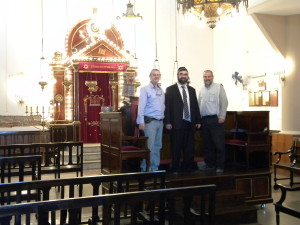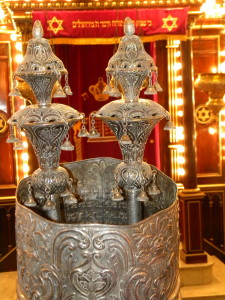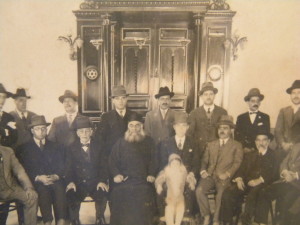 Jewish Revival in Resistencia, Argentina
Jewish Revival in Resistencia, Argentina
A Jewish Revival in Resistencia, Argentina is happening and Returnees to Torah observance are no longer a rarity in today’s world, and every Jewish community is blessed by their presence. But for one small secular Jewish community of fewer than 1,000 people to produce over two-dozen baalei teshuvah families in the last 15 years is remarkable. And when that community is located in rural Argentina, hundreds of kilometers from the nearest Orthodox enclave, it is truly astounding. One of the primary goals of our recent South American trip — about which we have previously written in these pages — was to visit kosher slaughterhouses and learn how the shochtim live in faraway locales, spending months away from home. One of these abattoirs was located so far from civilization that the shochtim who work there take a 12-hour, overnight sleeper bus from Buenos Aires to reach their destination. We thought we would be more clever and shorten our travel time by flying to a relatively close town, Resistencia, just a four-hour drive from that particular abattoir and home to the nearest airport. Jewish Revival in Resistencia, Argentina is happening.
reach their destination. We thought we would be more clever and shorten our travel time by flying to a relatively close town, Resistencia, just a four-hour drive from that particular abattoir and home to the nearest airport. Jewish Revival in Resistencia, Argentina is happening.
As long as we would be in Resistencia, we of course wanted to check to see if there was any sort of Jewish community in the town. And lo and behold, there are in fact Jews in Resistencia — and they are much more committed and dedicated than we could have ever imagined. Before we arrived we found out that the town has a shul, yet that was the extent of our knowledge of the place; after many calls and e-mails to contacts in the US, Israel, and Argentina, we found out about someone named Amalia who seemed like she would be a reasonable point person within the city. In the course of several e-mails to her, she was still hesitant to show us the synagogue and cemetery, insisting that they were all Reform and she was “chareidi.” Not sure what to make of a self-described chareidi in this remote location, we booked our tickets to Resistencia and headed out to see what was left of this 140-year-old community — hoping this woman would indeed prove to be a contact we could rely on. City of Surprises Boarding the flight in Buenos Aires to the provincial airport in Resistencia, we were quite surprised to see another frum Jew on the flight. Our traveling partner turned out to be Rabbi David Ariel Allami, a sofer from Buenos Aires of Syrian descent who was heading to the region to give a shiur that evening. That was our first hint that we’d find a lot more Jewishness in Resistencia than one old synagogue. Waiting at the airport was a welcoming committee from the local Jewish community, although we realized they were there to greet Rabbi Allami and not Ari and Ari. Nonetheless, it must have been quite a sight to see us, together with Rabbi Allami, exit the small airport and be greeted by three kippah-wearing Revolution men.
 The men told us that they were actually not from Resistencia, but from its sister city of Corrientes, which — we were equally surprised to hear — also had a Jewish community. (Who would have thought?) Giving us a quick historic overview of their town before they drove away with Rabbi Allami and we picked up our rental car, they told us that the town has both an Ashkenazi and a Sefardi shul. We soon met up at the 100-year-old Corrientes shul and were duly impressed by the condition of the building and its contents. While these three leaders of the community and their coreligionists are not what would be defined as “strictly Orthodox” they are clearly being drawn closer to Judaism in recent years. They did a complete refurbishing of their shul five years ago, which included the addition of a classroom.
The men told us that they were actually not from Resistencia, but from its sister city of Corrientes, which — we were equally surprised to hear — also had a Jewish community. (Who would have thought?) Giving us a quick historic overview of their town before they drove away with Rabbi Allami and we picked up our rental car, they told us that the town has both an Ashkenazi and a Sefardi shul. We soon met up at the 100-year-old Corrientes shul and were duly impressed by the condition of the building and its contents. While these three leaders of the community and their coreligionists are not what would be defined as “strictly Orthodox” they are clearly being drawn closer to Judaism in recent years. They did a complete refurbishing of their shul five years ago, which included the addition of a classroom.
They explained that education is of primary importance, and the classroom would be used to teach kids as well as for communal lectures, such as that evening’s talk by Rabbi Allami. This was the rabbi’s first visit to the town, but he has been teaching them via Skype and they anticipate this will not be his last visit. The shul also contained a magnificent kisei shel Eliyahu that has not been used for about ten years, but one of our three hosts, a 77-year-old man, told us that his bris had been on that very chair. The shul housed three sifrei Torah, although two of them were currently pasul, but given the current climate of religious enthusiasm, Rabbi Allami thinks it won’t be long before he’s asked to repair them. The silver on top of the Torahs had exquisite workmanship and they told us it had been brought over by immigrants from Syria more than a century ago. We asked to see the local mikveh and were told that there never had been one; rather, people would use the Río Paraná, the river that separates Corrientes and Resistencia. It was quite something to be in the middle of the Argentina countryside and to see Torah finials and crowns that had been made in the old country — Syria — and carried with love to this small ex-pat Syrian community in the backwoods of South America. There Must Be More We parted from our new friends and headed to Resistencia.
All good things need to be earned, and finding the house of our “chareidi” contact, Amalia, proved to be quite a challenge due to the one-way streets in her neighborhood. We knocked on her door and were greeted by a smiling, sheitel-wearing, middle-aged woman. Her English and Hebrew were rudimentary, and our Spanish not great, but within several minutes, a young, kippah-wearing Israeli with whom we were able to communicate joined us around the table. With all our initial skepticism, it turns out that Amalia’s house is, in fact, the nerve center of a teshuvah revolution. In order to understand how Torah is making its way back to this city, it’s worth reviewing the history of the Resistencia Jewish community. The town of Resistencia, founded in 1878, is located about 30 kilometers from Argentina’s border with Paraguay. Its growth was fueled by the timber and cotton industries, and owing to the economic potential, Jews began moving there as early as the turn of the 20th century. In 1905, about 50 Spanish-speaking Jewish families from Spanish Morocco moved to the town; similarly, Turkish Jews, mostly from Izmir, who had settled in nearby villages, also gravitated to the city. By 1910, the 400 Jews in Resistencia made up almost five percent of the city’s population. These early settlers were soon joined by some eastern European Jews who moved north from Baron Hirsch’s Jewish Colonization Association (JCA) farming villages.
In 1932 the governor of the province wrote a letter to the JCA that he had heard about the wonderful Jewish workers and that “It will be a blessing for our province to obtain the cooperation of the brave and energetic Jewish agriculturists.” Following World War One, eastern European Jews began coming in significant numbers. By 1939 there were over 1,100 Jews, about 700 Ashkenazim and about 400 Sephardim. In 1912 the Sephardim established the first organized community in the city; Ashkenazim were permitted to join but were not eligible to serve in leadership roles, and so in 1928 they established their own shul. The community was never particularly religious, but in the early years it remained staunchly traditional. By the 1960s, although some of the Jews had begun entering professional fields, many were still involved in commerce. In fact, most of the city’s retail stores were owned by Jews, many shops were closed on Shabbos and Jewish holidays, and Yiddish could be heard in the city center. There were many Jewish cultural and Zionist activities, although the religious component was weak and there was never a full time rabbi or any known talmidei chachamim. But with the passing of the founding generations, both the Jewish affiliation and the occupational patterns changed significantly. By 2000, intermarriage had hit almost 70 percent, there had been no local shechitah in town for decades, and the chevra kaddisha ceased to exist. The community began hiring Conservative cantors, and the Jewish stores were now open on Shabbos.
With the decrease in attendance, the Ashkenazi and Sephardic communities merged for whatever little religious activity they engaged in. And then something unusual began to happen. About 20 years ago, a local Jew named Reuven Tesisi found a book on Kabbalah in Spanish and he and his wife, together with Amalia Schejter and her husband (they subsequently divorced), began studying together. Their appetite whetted, they contacted the Kabbalah Centre in Buenos Aires, who provided material and teachers for a group that eventually numbered 20. But this group was no ordinary group looking for cheap spirituality. Amalia, who is a professor of philosophy, and her friends soon realized that there must be more to Judaism. They contacted Rabbi Shaul Elituv, a Chabad shaliach in Buenes Aires, and began studying with him. Within three years Reuven’s family was shomer Shabbos and had a kosher home. At the time, the official rabbi of the Resistencia community was a fairly traditional person who was teaching Reuven’s son David. However, even that rabbi proved too religious for the general community and in 1999 he was let go. When the community then hired a female “rabbi,” Reuven’s group made a total break from the official community. After hearing this, we finally understood Amalia’s emails and her reluctance to show us the synagogue and other community facilities. Around this time, Reuven began getting tapes of shiruim from Buenos Aires and soon also began learning via Skype with rabbis there. As the group increased in knowledge and observance, they slowly expanded their teacher base, although they are still in contact with Chabad shluchim, who send rabbinic students to visit for Yamim Tovim and other occasions. Secret Weapon In 2002 Amalia’s son Eliyahu — today a 29-year-old kollel student and yeshivah teacher in Jerusalem’s Ramat Shlomo neighborhood — moved to Buenos Aires for his last two years of high school to study in a yeshivah for outof-town baalei teshuvah run by Torah Umesorah of South America. Following high school, he completed a three-year graphics degree in ORT. He has remained good friends with Reuven’s son David — now a neighbor in Ramat Shlomo, and when we visited him in his Ramat Shlomo apartment following our trip, he reminisced about how he would listen to David’s Mishnayos tapes, and how he learned his first masechta, Taanis, using those tapes. He told us that when he and his wife moved to Ramat Shlomo four years ago and were invited out for their first Shabbos dinner, there was another closing of a circle: Their hostess was the daughter of the rabbi who made those tapes, and David is married to her sister.
David and Amelia’s son Eliyahu are now raising Torah families in Israel, but , Jewish Revival in Resistencia, Argentina — about two-dozen families have become full fledged baalei teshuvah. Eliyahu explains that his mother’s secret was inviting people for Shabbos meals. He told us about how he once went to the pool at the “Jewish club” in Resistencia where he met Gershon. Eliyahu invited Gershon to his mother’s home for his very first Shabbos meal, and he recently made sheva brachos for Gershon in his Ramat Shlomo apartment. And while all those initial individuals and families have made their way to larger, more normative Jewish communities, either in Buenos Aires or Israel, there’s one exception: Amalia is still there, and in the last 20 years she’s built up an entirely new generation. She used to head to Buenos Aires for the holidays, but no more. Last year she hosted an overflow minyan in her home, and Shabbos meals are still her secret weapon. Every Friday night her house is packed. There are over 30 regulars who come weekly for davening and then a seudah, some of them choosing to separate from their non-Jewish spouses or partners. Conveniently, two of the active members of this group who are getting closer to Judaism own supermarkets and they arrange to bring kosher items to town. So who was the young Israeli we met at Amalia’s house? He first showed up in town after following his girlfriend (now Eliyahu looks with awe at his good fortune, and says he feels G-d came in with tweezers and plucked him out from the middle of nowhere to bring him back to Torah his wife) across the ocean, spending Rosh Hashanah in the main synagogue. Coming from Israel, he assumed that the “shul you don’t go to” would still be traditional, so he was shocked when he saw the organ for cantorial accompaniment, the female clergy, and the definitely untraditional way the services were being held. Since then, he’s been a mainstay of Amalia’s group. Eliyahu related how he still looks with awe at his good fortune, and says he feels G-d came in with tweezers and plucked him out from the middle of nowhere to bring him back to Torah. The religious revival in Resistencia has been remarkable but it certainly isn’t over. Corrientes and Resistencia are working together and they are actually looking for a proper rabbi. We have put them in touch with some contacts and with G-d’s help, they will continue full throttle in their amazing individual and communal journeys.
text is from MIshpacha magazine